
Revised February 7, 2002
I have been interested in antennas since first getting my ham license. On this page, I plan to discuss some of the things I have been especially interested in, as well as share some of what I've done over the years.

And that's one of the most important things for your antenna: get it outside, as high up and in the clear as possible.
I wanted to have multiband operation, as I was optimistic that I'd someday break through that 13-wpm code barrier and make it to General. So a single band dipole wasn't what I was after. I wanted 40 meters, 15 meters, and 10 meters, at the very least.
For various reasons (most of which I can't remember anymore), I decided to go with a commercial multiband antenna. I saw ads from W9INN and from an outfit in Kearney NE called Western Antenna. I remember that I wrote to each of them, because I soon got their information packages back, and the guy in charge at each of them had taken the time to write a personal note in the margins of the advertising addressing my concerns and questions! (W9INN is still around, but Western Antenna is long gone now, I guess the OM went SK.)
I was intrigued by their selection of "sloper" antennas. You can consider these as half of a trap dipole, or a tilted vertical. These looked like the answer: not much space, multiband, hang it up in a variety of ways. I decided on one particular model from Western Antenna, and ordered it.
It arrived in a couple of weeks or so, and came ready to hang up, with full instructions. This one had one trap on it and was about 17 feet long. I don't even remember the model number of it or what bands I actually ordered it for, but I believe it was for 40 and 10. The trap was to separate the 10 meter section and with the trap acting as an inductor, the whole thing could work on 40 or 15 meters. (15 meters is the 3rd harmonic of 40 meters, so generally any antenna you make for 40 will work on 15 too.)
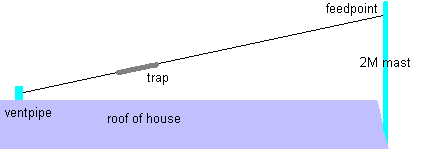 I ran it from an existing mast (for my 2M groundplane)
about 6 feet above the roofline of the house, out and down
to tie off on a water vent pipe on the roof.
I grounded the other side as best I could. I used a long ground rod
from Radio Shack, and several counterpoise wires laid along the
ground at the edge of the house.
I ran it from an existing mast (for my 2M groundplane)
about 6 feet above the roofline of the house, out and down
to tie off on a water vent pipe on the roof.
I grounded the other side as best I could. I used a long ground rod
from Radio Shack, and several counterpoise wires laid along the
ground at the edge of the house.
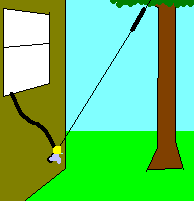
(The illustration for it showed it hooked onto a water faucet pipe on a
wall for the ground connection, the coax going up through a conveniently nearby window,
and the antenna itself sloping up into an equally conveniently-placed tree.
I suppose this setup would work for many people.)
I tried it out and it worked OK for me. Nothing spectacular, but it did far better than any indoor antenna did. In the interests of reducing any TVI complaints, I kept my power down below the max, generally 50-75 watts although the 735 could do 100 max. (I never did get any TVI complaints either, despite a total creep of a neighbor who voiced his "concerns" when I was installing the antenna.)
I was not any CW fanatic, so I didn't get onto 40 or 15 meters with it although I could have if I'd wanted. I used this antenna quite a bit on 10 meters SSB though. I checked the SWR, and the bandwidth on 40 was narrow but acceptable, and fairly good on 15 and 10.
During that time (1987) the
sunspot cycle
was in a so-so stage,
rising into Cycle 22 (the peak was from 1989-1991).
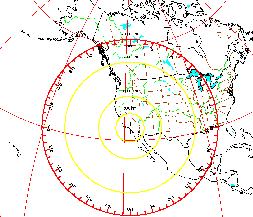 I quickly learned that when 10 meters was open,
there was a wide skip zone of at least 2000 miles.
From my QTH here in Southern California, I could make contacts on
an arc extending from Florida through the Carolinas and up through
the Great Lakes into Canada. This varied, but that was usually the story.
(This azimuthal map was generated online at
WM7D's Map Generator.)
I quickly learned that when 10 meters was open,
there was a wide skip zone of at least 2000 miles.
From my QTH here in Southern California, I could make contacts on
an arc extending from Florida through the Carolinas and up through
the Great Lakes into Canada. This varied, but that was usually the story.
(This azimuthal map was generated online at
WM7D's Map Generator.)
I talked to several Florida stations. I talked to one fellow in Indianapolis IN, on the very day of the Indianapolis 500. (He had no clue what was going on with the race in progress, the TV stations had the event blacked out in his area! The nerve of them!) I talked to a station in Colombia, and one in Alaska. I tried to get through a pileup when the band opened to Johnston Island, but I wasn't successful.
Locally I talked to several stations at night after the band closed. My sloper antenna was more horizontal than vertical, and some people couldn't hear me too well because they were using verticals. Fortunately everyone seemed friendly and we would often relay for each other.
I wanted to add more wires to it and fan them out in different directions. So I spliced some more wires right up at the feedpoint and tried it. (This is the legendary experimentation where I destroyed a noise bridge the first day I had it.) This worked out OK though, I improved 20 meter reception considerably with the extra wires. I probably detuned the primary bands a little bit, but I didn't notice any problems at the time.
I admit my HF interest varied, and for quite some time I was rarely on the air with the 735. One night a windstorm blew down a tree limb and tore down my antenna.
I was without anything for HF for a long time. Recently I got an endfed wire back up and that's what I'm using now until I can get something else up there.
One author mentioned in passing that hams have three antennas: the one you had, the one you have now, and the one you plan to have.
The Spider has several resonators that stick out in different directions. We had to adjust the tuning sleeves a little bit for the various bands, but once that was done it was ready to go! That's one impressive compact antenna and I think it's worth considering if you plan to go HF mobile.
During that trip, we took Jerry's own HF rig (I think he had a Kenwood TS-440 at the time) up to the lodge at the top of nearby Palomar Mountain and used that radio with the Spider up there at night on 10 meters. We talked to stations all over San Diego County from up there. That was one fun and memorable weekend.

By the way, L.B. Cebik, W4RNL, has a ton of great technical articles about antennas. He's someone I'd like to meet sometime.
I keep hearing various hams saying they want to go out and buy a "G5RV Antenna." To help clear up some misinformation, G5RV is not a brand of antenna, like a Cushcraft, Butternut, Smiley, GAP, Spider, Force 12 or whatever. The antenna commonly referred to as the G5RV is a design by Louis Varney G5RV. Although various manufacturers offer this type of antenna ready-to-go, it's something you can probably build yourself for a lot less.
The G5RV is a doublet, 51' each side of center (102' along the flattop), with about 35' of twinlead or open wire feeder going to a 4:1 balun, and with coax the rest of the way into your shack. The length on top is about 1.5λ for the 20m band. The twinlead can be 450Ω ladder line, or open-wire feedline.
My feeling is that this is just a specialized version of an extended double zepp, optimized for the 20m band. You'd probably be better off to use balanced twinlead all the way to the antenna tuner in your shack, because of these things:
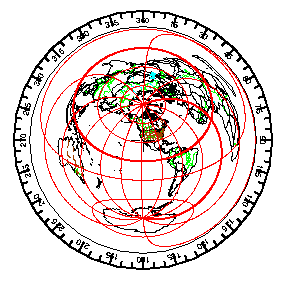 These give the same directivity broadside to the wire,
in case you're intentionally aiming the wire you strung up
for a desired coverage pattern.
There's no reason you can't use the 88' one on 17-10m, but
on the upper bands you start getting lobes going off in
different directions.
This may not be undesirable, because you're likely to get good gain
from such an antenna anyway.
These give the same directivity broadside to the wire,
in case you're intentionally aiming the wire you strung up
for a desired coverage pattern.
There's no reason you can't use the 88' one on 17-10m, but
on the upper bands you start getting lobes going off in
different directions.
This may not be undesirable, because you're likely to get good gain
from such an antenna anyway.
My opinion is that the G5RV looks like a good design, and he
argued well for its merits.
But the requirements of specific lengths for the feedlines
and flattop, and a balun, make it too site-specific for me.
It has to be set up under optimal conditions, and I just don't have the
space it needs.
These reasons and others may account for why some people have reported
less than perfect
results using the G5RV versus a dipole.

From what I can see, one of those skywires and I might not need anything else. Here are the advantages: it's a loop, so there's little static buildup from the wind, and less receive noise. It has NVIS characteristics on 80/75 meters, which is good for working locals in the daytime. On higher frequencies, the takeoff angle gets lower and it can be a great performer on 20 meters and up.
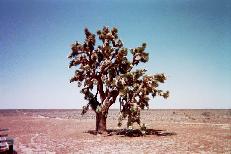 N7JY and I are currently assisting another ham friend in planning
for an HF antenna at his remote hamshack in the Mojave Desert,
6 miles from the boundary of
Edwards AFB.
We are thinking of putting up a full sized skywire for 160m!
He's got most of 10 acres with nothing on it but sagebrush,
and only one joshua tree, which isn't even in the way.
Think about that! One antenna for use on all nine HF bands
(160, 80/75, 40, 30, 20, 17, 15, 12, and 10 meters).
(The big problem is what to use for the supports. Surplus telephone poles?)
More to come on this if it pans out.
N7JY and I are currently assisting another ham friend in planning
for an HF antenna at his remote hamshack in the Mojave Desert,
6 miles from the boundary of
Edwards AFB.
We are thinking of putting up a full sized skywire for 160m!
He's got most of 10 acres with nothing on it but sagebrush,
and only one joshua tree, which isn't even in the way.
Think about that! One antenna for use on all nine HF bands
(160, 80/75, 40, 30, 20, 17, 15, 12, and 10 meters).
(The big problem is what to use for the supports. Surplus telephone poles?)
More to come on this if it pans out.

Wayne sometimes gives talks at ham conventions about his various exploits, including a fantastic slide show on his mountaintopping expeditions to Nevada and Utah and other remote places. Worth attending.

1. McCoy, Lewis (W1ICP). "Let's Meet Mr. Ionosphere,"
QST, August 1954.
And of course, don't forget about the
ARRL's publications,
including the ARRL Antenna Book and various others.
2. McCoy, Lewis (W1ICP). "Basic Antenna Information, Part 3,"
CQ, August 1990.
3. Stocking, William (W0VM). "Tuned Feeders and Other Good Stuff,"
73 Magazine, December 1978.
4. Stocking, William (W0VM). "Four Bands on a Bamboo Pole,"
73 Magazine, September 1979.
5. Stocking, William (W0VM). "HF Antennas: All Bands, All Wire,"
73 Magazine, September 1986.
6. Stocking, William (W0VM). "Resonant Wire Antennas,"
73 Magazine, September 1986.
7. Fischer, Dave (W0MHS). "Loop Skywire, The,"
QST, November 1985.
8. Mix, Don (W1TS), "Antennas for Domestic Work,"
QST, September 1941.
9. Janker, Christoph (WD4CPK/DF3TJ), "'German' Quad, The,"
73 Magazine, photocopied, date unknown (1978?).
10. Carr, Paul D., "Full-Wave 80 Meter Loop Antenna - Revisited, The"
CQ, August 1990.
11. Overbeck, Wayne (K6YNB/N6NB). "VHF Quagi, The"
QST, April 1977.
12. Overbeck, Wayne (K6YNB/N6NB). "Technical Correspondence,"
QST, April 1978.
13. Overbeck, Wayne (K6YNB/N6NB). "Long-Boom Quagi, The"
QST, February 1978.


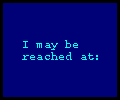
Copyright © 2001-2002 David G. Bartholomew, AD7DB. |
 Disclaimer:
Disclaimer:The contents of these pages do not necessarily reflect the opinions of my Internet provider, my page host (QSL.net), my employer, nor anyone else. |

|